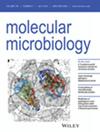实验进化的耳念珠菌分离株的多组学分析揭示了固醇、鞘脂和氧化应激在获得性两性霉素B抗性中的调节作用
IF 2.6
2区 生物学
Q3 BIOCHEMISTRY & MOLECULAR BIOLOGY
引用次数: 0
摘要
临床分离的耳念珠菌对两性霉素B (AmB)具有较高的耐药性,这在大多数念珠菌中是不常见的。麦角甾醇生物合成的改变可导致耳球菌实验室菌株获得性AmB耐药,但在临床分离株中很少见到。在这项研究中,我们实验进化了两株对药物敏感的C. auris Clade II分离株,使其产生AmB耐药性。与亲本细胞相比,进化菌株的MIC50增加了4到8倍。我们分析了与这种获得性耐药性相关的核型、基因组、脂质组和转录组的变化。在一个谱系中,AOX2上调,其缺失逆转了AmB抗性表型。在实验条件下,aox2Δ突变体也未能进化出AmB抗性。在同一谱系中,将UPC2S332R和RTG3S101T突变恢复为野生型等位基因可以恢复AmB的易感性。在另一个谱系中,麦角甾醇和鞘脂通路被观察到发挥关键作用,ERG基因的上调提高了总甾醇含量,而HSX11(葡萄糖神经酰胺合成酶)的显著下调导致葡萄糖神经酰胺水平降低。据我们所知,这项研究首次表明,C. auris可以通过依赖或独立于甾醇含量调节的机制获得AmB耐药性,突出了Aox2和Upc2是两性霉素耐药性的关键调节因子。本文章由计算机程序翻译,如有差异,请以英文原文为准。

Multi-Omics Analysis of Experimentally Evolved Candida auris Isolates Reveals Modulation of Sterols, Sphingolipids, and Oxidative Stress in Acquired Amphotericin B Resistance
Clinical isolates of Candida auris show a high prevalence of resistance to Amphotericin B (AmB)—an uncommon trait in most Candida species. Alterations in ergosterol biosynthesis can contribute to acquired AmB resistance in C. auris laboratory strains but are rarely seen in clinical isolates. In this study, we experimentally evolved two drug-susceptible Clade II isolates of C. auris to develop AmB resistance. The evolved strains displayed a four to eight fold increase in MIC50 compared to the parental cells. We analyzed changes in their karyotype, genome, lipidome, and transcriptome associated with this acquired resistance. In one lineage, AOX2 was upregulated, and its deletion reversed the AmB resistance phenotype. The aox2Δ mutant also failed to evolve AmB resistance under experimental conditions. In the same lineage, restoring the UPC2S332R and RTG3S101T mutations to the wild-type allele restored AmB susceptibility. In another lineage, the ergosterol and sphingolipid pathways were observed to play a critical role, and upregulation of the ERG genes elevated the total sterol content, while significant downregulation of HSX11 (glucosylceramide synthase) resulted in lower levels of glucosylceramides. To our knowledge, this study is the first to show that AmB resistance in C. auris can be acquired through mechanisms both dependent on or independent of sterol content modulation, highlighting Aox2 and Upc2 as key regulators of amphotericin resistance.
求助全文
通过发布文献求助,成功后即可免费获取论文全文。
去求助
来源期刊

Molecular Microbiology
生物-生化与分子生物学
CiteScore
7.20
自引率
5.60%
发文量
132
审稿时长
1.7 months
期刊介绍:
Molecular Microbiology, the leading primary journal in the microbial sciences, publishes molecular studies of Bacteria, Archaea, eukaryotic microorganisms, and their viruses.
Research papers should lead to a deeper understanding of the molecular principles underlying basic physiological processes or mechanisms. Appropriate topics include gene expression and regulation, pathogenicity and virulence, physiology and metabolism, synthesis of macromolecules (proteins, nucleic acids, lipids, polysaccharides, etc), cell biology and subcellular organization, membrane biogenesis and function, traffic and transport, cell-cell communication and signalling pathways, evolution and gene transfer. Articles focused on host responses (cellular or immunological) to pathogens or on microbial ecology should be directed to our sister journals Cellular Microbiology and Environmental Microbiology, respectively.
 求助内容:
求助内容: 应助结果提醒方式:
应助结果提醒方式:


